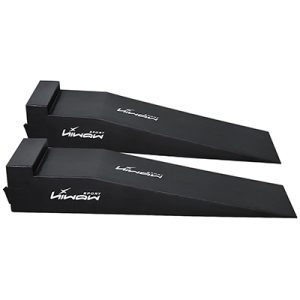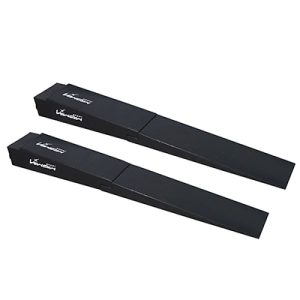Evaluating the stability of a car ramp, whether for vehicle maintenance, loading, or parking, involves assessing several key factors. Here’s a detailed guide on how to evaluate the stability of a car ramp:
1. Weight Capacity and Load Distribution
- Ramp Rating: Ensure the ramp is rated for the maximum weight of the vehicle. The weight rating includes the car’s full load (vehicle, fuel, cargo, passengers).
- Uniform Load Distribution: The ramp should be capable of distributing the vehicle’s weight evenly to avoid excess pressure on any single point, which could lead to structural failure.
- Evaluation: Check the manufacturer’s specifications for the ramp’s weight limit. Position the vehicle so that its weight is evenly distributed across the ramp.

2. Material Strength and Quality
- Material Type: Car ramps are commonly made from steel, aluminum, or heavy-duty plastic. Each material has a different strength, durability, and load-bearing capacity.
- Deformation Resistance: The ramp should not bend, warp, or deform under the vehicle’s weight.
- Evaluation: Inspect the ramp for visible signs of stress, cracks, rust, or deformations. If the material shows any wear or weakness, it could compromise stability.
3. Ramp Angle and Gradient
- Angle: Steeper ramps are less stable and increase the risk of vehicles slipping or rolling. Ideally, a ramp should have a gentle incline to ensure vehicle safety.
- Height vs. Length: A longer ramp with a lower incline provides a more gradual ascent and better stability.
- Evaluation: Measure the ramp’s incline angle using an inclinometer. Ensure that it provides a safe and controlled approach for the vehicle.
4. Surface Grip
- Traction: The ramp surface should offer enough friction to prevent the vehicle from slipping, especially during ascent and descent. Look for non-slip surfaces or textured designs.
- Material Coatings: Some ramps are coated with anti-skid materials (e.g., rubber or treaded designs) to increase grip.
- Evaluation: Inspect the ramp’s surface for adequate grip. Test the ramp under different conditions (e.g., dry and wet) to ensure it prevents slippage.
5. Ramp Width and Stability Base
- Width: The ramp must be wide enough to accommodate the vehicle’s tires, providing full contact between the tires and the ramp’s surface.
- Base Stability: The base of the ramp should be wide and stable, preventing it from tipping or shifting while the vehicle is on it.
- Evaluation: Measure the width of the ramp and compare it to the width of the vehicle’s tires. Ensure that the base is sturdy and does not shift or wobble when weight is applied.

6. Ramp Alignment and Leveling
- Even Positioning: The ramps must be positioned evenly, ensuring that both ramps are on a flat, stable surface and at the same angle.
- Level Ground: Use the ramp on a flat surface to maintain stability. Uneven or sloped ground can cause the ramp to tilt, making it unsafe.
- Evaluation: Before driving onto the ramp, check that both ramps are level with each other and positioned on even ground. Use a level tool if necessary.
7. Safety Features
- Safety Locks and Braces: Many ramps come with safety locks or braces to secure them in place once the vehicle is positioned. This helps prevent the ramp from moving or collapsing under load.
- Wheel Stops: Some ramps have built-in stops at the top to prevent the vehicle from rolling off the end.
- Evaluation: Check for safety locks or latches, ensuring they engage properly. Test wheel stops to ensure they are functional and secure.
8. Ramp Flexibility and Movement
- Minimize Flexing: The ramp should not flex or move when the vehicle is driven onto it. Excessive flexing can indicate that the ramp is not strong enough to handle the load.
- Side-to-Side Stability: Ensure the ramp remains stable laterally and does not shift when the vehicle is in place.
- Evaluation: Once the vehicle is on the ramp, observe for any flexing or side-to-side movement. If the ramp moves, it could indicate instability.

9. Maintenance and Condition
- Regular Inspection: Ramps should be regularly inspected for signs of wear, corrosion (in metal ramps), or material degradation (in plastic ramps).
- Lubrication and Cleaning: Ensure any mechanical parts (like hinges on folding ramps) are lubricated and that the ramp is free of debris that could reduce friction.
- Evaluation: Perform regular maintenance checks and clean the ramp to prevent any buildup that could affect stability.
10. Height of the Ramp
- Appropriate Height: The height of the ramp should suit the intended use. Higher ramps can be less stable unless properly reinforced.
- Support Bracing: For taller ramps, ensure that support braces or stands are in place to prevent tipping.
- Evaluation: Verify that the ramp height is appropriate for the task at hand. Use additional support if necessary.
11. Use of Chocks and Stabilizers
- Wheel Chocks: Place wheel chocks behind the tires not on the ramp to prevent the vehicle from rolling backward.
- Stabilizers: Use ramp stabilizers or additional supports to reinforce the ramp during use.
- Evaluation: Ensure chocks are properly placed behind the wheels, and use additional supports if needed.
12. Environmental Considerations
- Weather Conditions: Wet or icy conditions can affect the ramp’s grip and stability. Ramps used outdoors should be designed to withstand environmental factors.
- Evaluation: Test the ramp in different weather conditions to ensure its surface and stability remain reliable.
We are the first factory in China to produce this type of product. We can produce according to any size of yours, and we can OEM for you. If you have any information about this market, please remember to welcome us to communicate.









